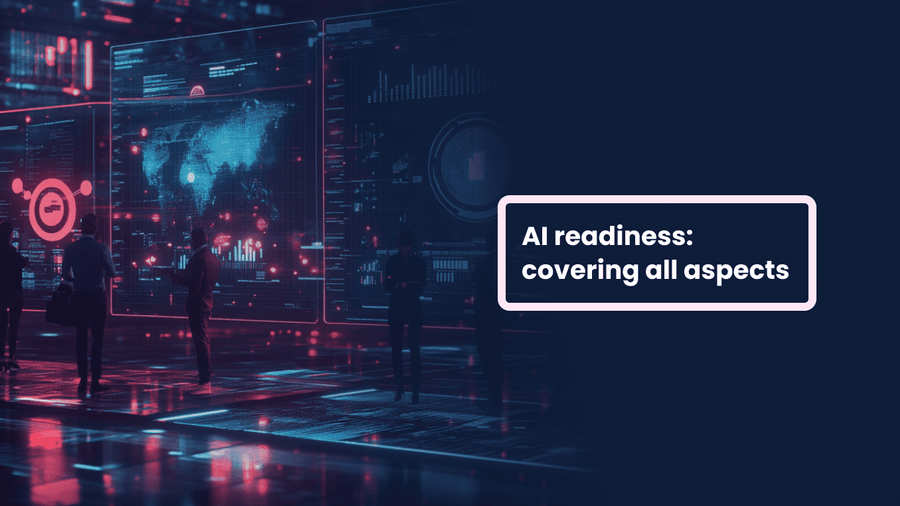Remember Apple’s “There’s an App for That” campaign from 2009? We’ll soon be able to say the same for generative AI.
The explosive growth of the AI market is no longer surprising news, but a fully expected exponent. It is expected to grow almost 6.5 times between 2024 and 2030 with an approximate CAGR of 37.3%.
Used correctly, AI will help businesses thrive in different industries. However, the likelihood that your AI project will not deliver the promised ROI or will ultimately fail is still very high. According to Gartner experts, nearly a third of generative AI projects will be abandoned after the PoC stage by the end of 2025.
Why doesn’t market growth correlate with the perceived success of AI projects? The reason is that preparing for a launch involves many levels at which an organization must be ready to incorporate AI features into existing frameworks, much less launch them from scratch.
In this article, we’ll break down how to determine business readiness in different aspects. we asked our СТО Aleksei Turchak to assist in creating this article, to share his experience and vision from customer interactions Keep reading to learn more!
Aspects of AI readiness
Strategic aspects
1. Сlear understanding of the problem or objectives
AI is often pursued without evaluating whether it is the most suitable solution for the problem at hand. This approach frequently leads to poorly defined business challenges, which is a critical barrier to developing a successful AI strategy.
Also, without understanding the goals, there will be no metrics you will use to measure success.
2. Measurable ROI or business value assessment
Measuring potential returns requires a transparent understanding of how AI will reduce costs, improve efficiency, or increase long-term revenue.
In addition, as part of your AI implementation strategy, you need to calculate a budget that will cover the development and possible associated costs.
Сalculate the cost of AI-based software development
Answer a few questions about your project and we will provide an estimated development cost.
3. Key stakeholders alignment and all-round involvement
Decision-makers like CTOs, CISOs, or department heads may not be fully aware of the initiative being introduced. As a result, they may lack consensus on its goals and impact.
For example, a CTO may focus on AI’s potential for long-term innovation, such as transforming product offerings, while a company’s project manager may prioritize using AI to automate customer support.

4. Governance framework and ethical guidelines
AI governance is not only a strategic concern, but also a social and ethical one. It plays a crucial role in fully exploiting the potential of AI while minimizing its risks, from loss of customer trust and unlearning important skills because too much work is left to AI, to biased decision-making processes.
In the area of data security and privacy, AI governance standards are critical to protect personal data and ensure compliance with data security and privacy laws. Therefore, AI usage must be thoroughly monitored to address ethical concerns like bias or fairness.
Technical aspects
1. Streamlined data handling
Data availability is fundamental to the success of adopting AI initiatives within your business. Before planning an AI-based project, it’s essential to clarify the scope of available data, formats, and real-time data availability. After you access its quality and completeness, you’ll be able to make valuable insights and ensures the reliability of AI algorithms.
Also, analyze what data sources you have and what analytics systems exist to collect, clean, and store the data.
Signs that an AI implementation might fail to deliver results or work as intended include the following:
- Data collection and partitioning are time-consuming and costly.
- Extracting relevant information and customizing data sources is challenging.
- Poor data quality requires additional solutions for improvement.
- Slow data collection delays progress and results.
- Noise, bias, and variability reduce algorithm objectivity and model accuracy.

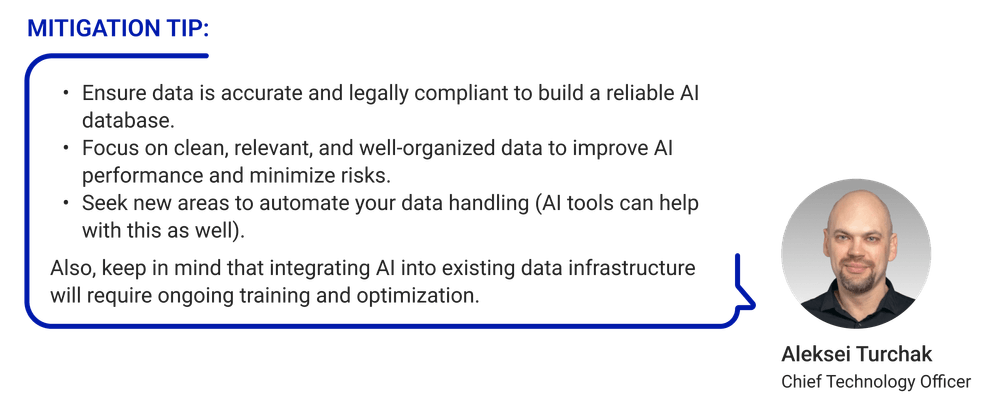
Centralized data system for a US eLearning provider
Aristek’s team turned a lake of unstructured data into a well-organized warehouse of data, which became the foundation for a robust data analytics system. Learn how the completed project has become the foundation for long-term development.

2. Eligible in-house expertise and technical skills
Preparing for AI implementation in all aspects is 50% of the work. Given the planned work’s complexity, your team may not have AI, data science, or DevOps development experience, and have no targeted hiring or upskilling plans.
The other 50% involves working with a vendor, if you’ve already chosen one.
If not, what should you consider when making your selection? There are many subpar companies in the industry offering data collection services, so it’s essential to choose your partner carefully.
For instance, ensure the development company has the expertise and capacity to create customized AI models and systems tailored to your needs. To be sure of the other details of the future cooperation (and be aware of possible red flags!), read the dedicated article.
If you find it difficult to make a choice, there are consultants with technical expertise who can help you choose a vendor.
The perfect collaboration requires questions or factors to be answered or explained in more detail. To save a lot of time in the AI project planning phase, use a free checklist below to prepare before speaking with your chosen vendor.
- The AI readiness checklist is free, straightforward, and quick – and can be carried out by people from a wide range of departments.
- You will get a trustworthy overview of how will you and your customers use AI.
- You will find out what initial requirements you need for a promising launch.
3. Planned functionality vision
The envisioned functionality of a future solution directly influences how AI integrates into existing processes and supports business objectives. Possible AI functions could include predictive analytics for sales forecasting, automated content generation for e-learning, and many more – each of which must ensure the availability of the right data, skilled staff, and a well-defined workflow to support this initiative.
Without a clear vision for these functionalities, the company risks wasting resources and missing valuable opportunities.
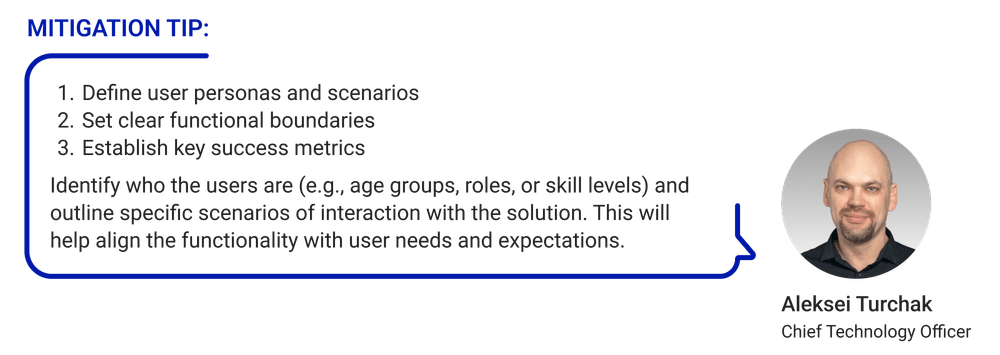
Using research tools such as the OSINT (Open-source intelligence) framework, you can assemble a suitable service pipeline and improve your lead research. It allows you to harness data from search engines and social media and split it into various categories related to your investigation.
Also, determine the scope of what the AI will and won’t do. For example, specify if the chatbot will provide general answers, personalized responses, or handle complex queries, and clarify any limitations in data handling or context comprehension.
4. AI security and risk mitigation
Although generative AI offers groundbreaking capabilities, it also poses significant challenges in
the area of data security. The reliance on large amounts of data – from structured to unstructured – means that data lakes and data warehouses must be effectively secured to prevent security breaches.
In addition, errors in AI systems can lead to greater security risks as they can inadvertently reveal sensitive information or disrupt important services.
Therefore, if your data handling and AI practices do not align with relevant standards, you may not mitigate AI risks accordingly.
Organizational aspects
1. Growing a culture of change
Employees or departments may be hesitant to adopt AI tools or processes, fearing disruption or job displacement. Changing daily work routines means extra effort and, depending on the type, also creates uncertainty. No surprise: AI could be responsible for the loss of 83 million jobs in the next few years. The spectrum ranges from suppliers, who could be replaced by autonomous cars and drones, to production and even white-collar jobs.
If digitalization is on the horizon, this means a huge change that can be unsettling.
On the other hand, workers who believe AI will help them daily are more confident in their career progression, with 70% feeling they have the necessary skills to advance in the next 3 years.
Therefore, companies must establish clear policies for human focus, inclusion, accountability, and transparency to make all AI initiatives future-ready.
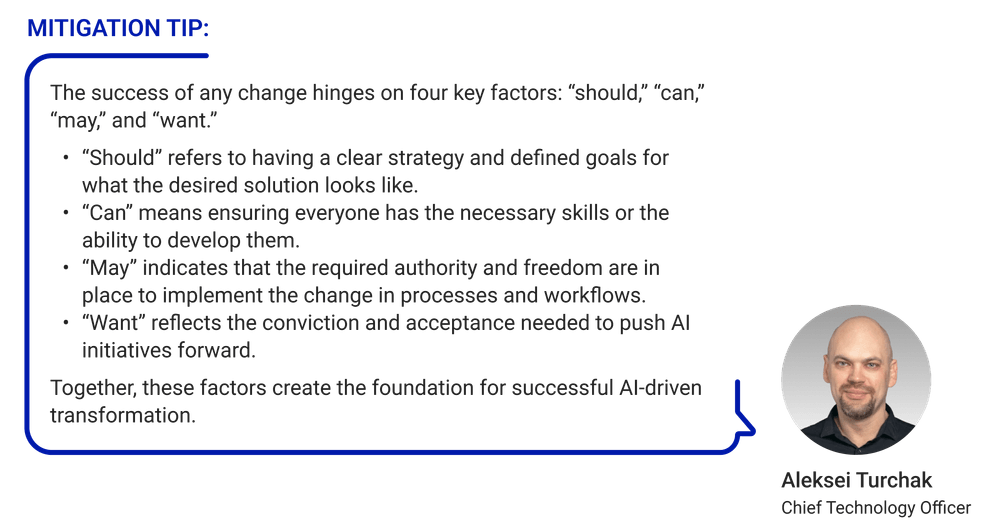
2. Well-educated team
Staff may be unprepared to interpret or work alongside AI-driven insights or tools. And for AI to gain trust at scale, people need to understand how it works.
Good documentation of how models work, intended use cases, and limitations are critical to ensure transparency around the technologies. Comprehensive communication of uncertainties and limitations is also crucial to employees and customers so they have realistic expectations about the capabilities and limitations of AI.
3. AI-adapted workflows and processes
Existing workflows should easily integrate with AI systems. No matter how advanced AI systems are, they must work alongside humans, not replace them. Companies need transparency about where and how AI is being used, the ability to interpret its results, and the capacity to adjust or override AI decisions when necessary.
With all the above aspects in mind, you can confidently start looking for an AI solution developer.
Make sure your business is fully prepared at the Discovery Phase
Is it possible to ensure a successful collaboration with a vendor and evaluate the project in advance?
Before implementing artificial intelligence in the company on a large scale, it is advisable to test the suitability of your ideas. The feasibility and benefits of AI applications can be tested in a controlled environment to gain valuable insights for further implementation.
Such an environment exists within the scope of the Discovery Phase.
In essence, it encompasses the entire process of identifying your needs and the actions taken by the implementing company to address them. This is one of the most critical phases of an AI project, as its outcome directly impacts the quality of the product or service you expect.
The Discovery Phase can also help to identify potential challenges and risks at an early stage and develop appropriate countermeasures.
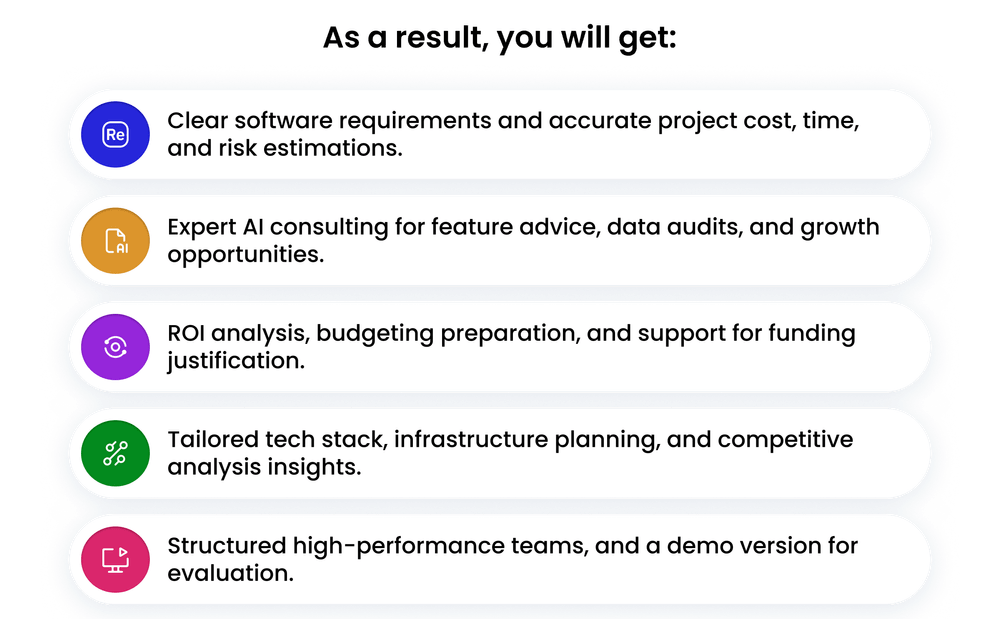
The first step toward a successful AI project
More details about Discovery Phase and why this step is also important for the vendor.
Conclusion
The newly developed AI solution should be adapted to the company’s needs, right down to the daily activities of employees on site. Achieving acceptance will not always be easy, especially if roles and responsibilities change as a result of the introduction of AI.
Therefore, it should not be forgotten that an AI project is a “never-ending story”. Unlike other traditional IT projects, an AI project is never really finished, and the system must be constantly trained with new data.
Don’t let a rough start with AI make you miss out on the great value it can create in your organization – contact the Aristek team today and ensure a confident start with a vendor you can trust.
